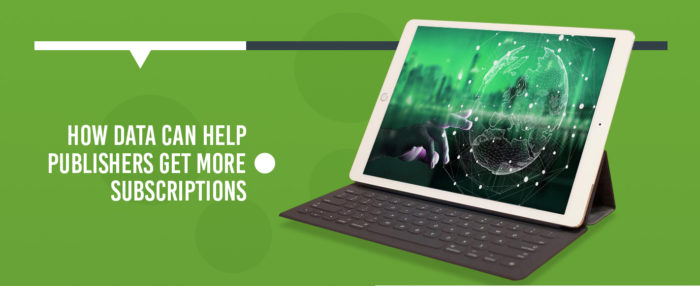
Subscriptions are re-emerging as a viable way for publishers to earn revenue from their content. While the overall numbers are still relatively small, the proportion of people who pay for their news is growing. In the United States, the percentage of people who pay for news rose from nine percent to 16 percent from 2016 to 2017, according to a survey by the Digital News Project from the Reuters Institute for the Study of Journalism. Eight percent of those paying for news in 2017 paid ongoing subscriptions, while the other eight percent paid in other ways such as one-off purchases or donations.
Although the rise of digital news subscriptions is a relatively recent phenomenon, a growing portion of publishers’ revenue is expected to come from subscriptions over the coming years. Other types of publishers could experience a similar situation.
These trends have inspired publishers to look for ways to increase subscriptions. Data is one of the most powerful tools for achieving this. When publishers use a data management platform (DMP) to collect, organize and activate their data, they can gather insights from it that allow them to create more engaging content, determine what motivates their readers to purchase subscriptions and take steps to get more readers to subscribe.
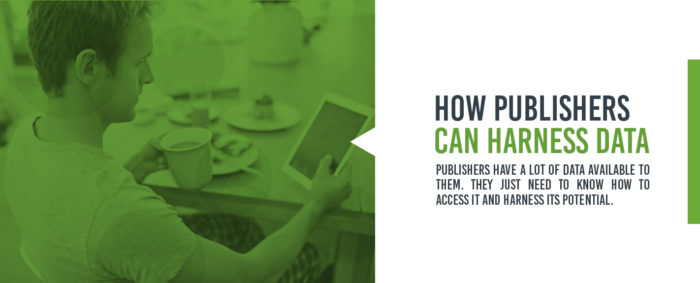
How Publishers Can Harness Data
Publishers have a lot of data available to them. They just need to know how to access it and harness its potential. First-party data, the information publishers collect directly from their audience, provides useful information about user demographics and behaviors on the site. Companies can increase their knowledge by accessing second-party and third-party data, which is information from other companies and data exchanges, to get more complete information about users and find similar users.
All of this data is useless, however, if the publisher can’t collect, organize and activate it. This is where a data management platform comes into play. A DMP serves as a place to collect data, no matter what source it comes from, in one place. You can also use your DMP to organize your data and discover insights about your customers through data analysis. Additionally, you can connect your DMP to other platforms, such as your content management system (CMS), to send customized content and messaging based on the audience a particular user falls into. This leads to increased engagement and time on your site, so your readers keep coming back for more.
With a DMP and a well-planned data strategy, you can use this same information you collect to grow your subscriber list.
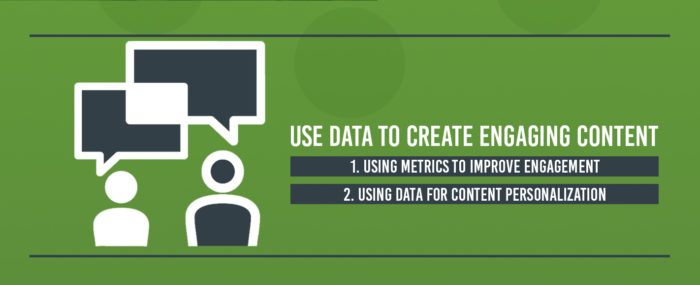
Use Data to Create Engaging Content
The foundation of any successful media business is quality content. For those companies that make subscriptions a core part of their business model, this will be even more important. That content also has to be engaging to ensure success.
Research from the American Press Institute shows content quality is a significant factor affecting whether subscribers stay with a publication. Of the study participants, 78 percent cite accuracy, and 68 percent cite dealing fairly with all sides as reasons they use their chosen publications.
Publishers also have to work to encourage engagement with their readers in a variety of forms. They need engagement in the form of readers actively subscribing. They also need to make their sites’ content is engaging for their readers, so people continue to visit the site and renew their subscription. Engagement in the form of users sharing articles with others can also be a powerful promotional tool.
1. Using Metrics to Improve Engagement
Customer data can help publishers make their content more engaging and help them gauge which content they believe is of high quality. Publishers can gain valuable insight by tracking and assessing metrics such as:
- Session length, or the amount time users spend on a publisher’s site
- Bounce rate, or the proportion of visitors who leave the site after viewing just one page
- Volume of newsletter sign-ups
Publishers can explore user data to determine which articles were most popular, and which were most likely to inspire someone to purchase a subscription. Companies can analyze overall trends in content popularity and identify the characteristics the most popular items have in common.
Perhaps coverage of a particular topic resonates particularly well. Maybe a specific writer consistently creates top-performing articles. Are videos, infographics, articles or image galleries most popular, and how does that differ from topic to topic and from demographic to demographic? The number of questions you can ask and answer using data is virtually endless.
Publishing companies can use these answers to inform their content creation strategies, purposely creating what they know is popular with their user base. This means their content will be more relevant to their users and more likely to engage them. This increased engagement can eventually lead to more subscriptions.
2. Using Data for Content Personalization
Another compelling use of data in publishing is customizing the user experience for different groups of site visitors or even individual users. Content personalization through the use of data enables companies to show site visitors content tailored specifically to their interests when they go to the site. When a website shows users more of the type of material they’re interested in, they create a more engaging experience for that user.
To personalize content, publishers use data on their users, such as demographic information and behavior while on the site, collected with a DMP. Using data from second and third parties can help to make your knowledge more accurate and complete.
You can organize user profiles into segments based on the characteristics they have in common. You can create groups based on whichever factors you want. In this case, it makes sense to define groups based on the type of content they prefer. For example, you could create separate segments for those interested in sports, those who read news articles and those who prefer content about fashion. You could also organize your audience by demographic data such as age, gender or where they live.
If a particular user has visited your site before, you’ll have even more detailed information and can tailor the content you show to their individual preferences. If you know they like viewing sports-related content, for example, you could suggest more sports articles to them than you do to other readers.
To drive this content personalization and recommendation, you can integrate your DMP and your CMS. This enables your CMS to display personalized content to users in real time. Every time a user clicks on an article or video, you’ll get more data, meaning your information and your recommendations get more accurate the longer someone spends on your site.
TownNews.com, a company that works with a network of more than 1,700 sites, used the Lotame DMP to drive content personalization. The result was a decrease in bounce rate of 854 percent and an increase in session duration of 120 percent.
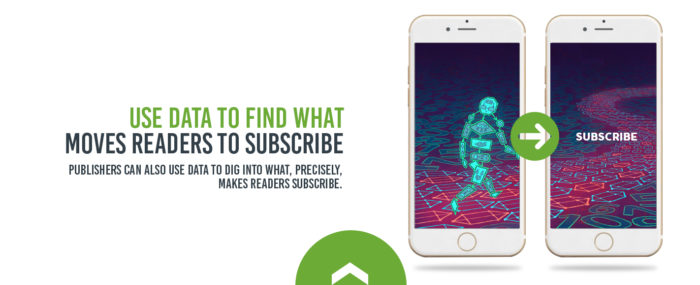
Use Data to Find What Moves Readers to Subscribe
Publishers can also use data to dig into what, precisely, makes readers subscribe. Several organizations have researched this area, but the factors most likely to inspire someone to make a purchase differ from site to site. Knowledge in this area can help publishers sell subscriptions and boost their revenue stream.
There are various ways in which data can help publishers learn more about their audience and improve their subscription-selling strategy. Companies can explore what types of articles are popular with the readers who eventually subscribe as opposed to those who visit the site occasionally but never make a purchase. It can also reveal other information about the users who subscribe, which can help companies predict who is most likely to make a purchase.
Data can reveal which articles people were viewing when they decided to subscribe, which could offer clues into what drives people to sign up. According to the Digital News Project survey, breaking news was the type of content that most often motivated people to pay. The results may be different for your specific publication, though. Additionally, data can help publishing companies determine what works well and what does not when actively encouraging readers to hit the subscribe button.
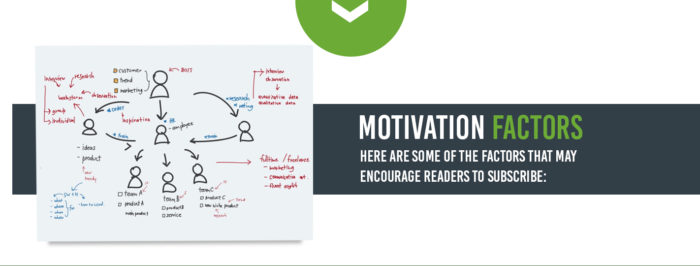
Motivation Factors
Here are some of the factors that may encourage readers to subscribe:
1. Interesting Articles
The first reason why people may pay for access to a site goes back to high-quality, engaging content. Many users decide to purchase a subscription because they see a large volume of interesting or useful articles on the site. In the American Press Institute survey, 40 percent of participants gave this as a reason they paid for subscriptions.
The types of articles that people find interesting varies. You can use data to gain insight into which types of content your user base finds most interesting. In some cases, a user might mostly be interested in one or two subjects. In others, viewers might find the majority of your posts interesting in a more general sense. Many people also have a high interest in local news, since it affects them directly, so local news sites may be able to pull in subscribers based on that factor. This may be especially true for people who recently moved to a new area.
2. A Desire to Support Journalism
Many users see value in journalism and wish to support it. One way in which they do so is purchasing subscriptions to news publications. According to the Digital News Projects, 29 percent of Americans who paid for their news said they wanted to fund journalism. People may feel especially strongly about local journalism, because small, local businesses often run these papers and because people value local news. Similarly, the American Press Institute survey found 31 percent of respondents said they wanted to support local journalism. These facts suggest publishers may be able to sell subscriptions by promoting the idea of supporting journalism in their promotional materials.
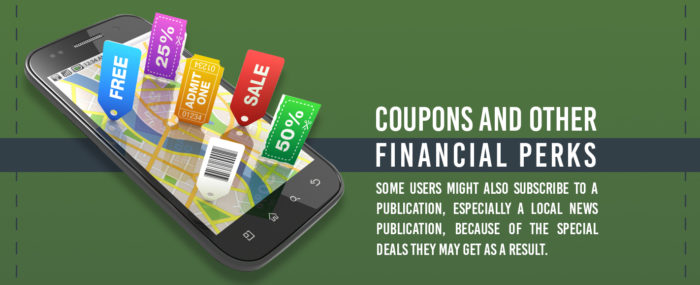
3. Coupons and Other Financial Perks
Some users might also subscribe to a publication, especially a local news publication, because of the special deals they may get as a result. The American Press Institute survey indicates 52 percent of subscribers use coupons they get from the media to which they subscribe. They might also want to be the first to see ads about special deals or other events happening nearby.
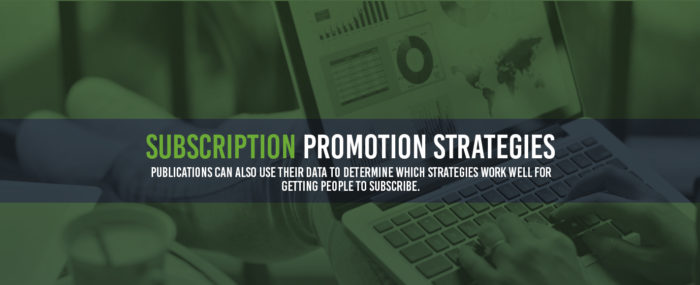
Subscription Promotion Strategies
Publications can also use their data to determine which strategies work well for getting people to subscribe. Some of the most effective strategies are:
1. Article Limits
According to the American Press Institute, half of all digital subscribers decided to make their purchase decision after hitting a paywall meter. This strategy involves giving users a certain number of free articles, then requiring payment once they have reached that limit. The readers who are most interested in your content will want unlimited access and may purchase digital subscriptions.
To make this approach more successful, publications can test varying limits and see which ones work best. You may find different limits work best for different types of users and decide to adjust the limits based on the readers’ characteristics.

2. Special Promotions and Free Trials
Another common strategy is offering special promotions or free trials. These offers may convince users who were previously on the fence to try a subscription. The American Press Institute survey found this tactic was effective in convincing users to take the final step and subscribe. In 45 percent of cases, a special offer or free trial was the final trigger that caused a user to sign up.
Publisher data about user activity on a site can help publications optimize their strategy for when to offer such special deals. Again, testing variations of this can help to find which one works best for your site. The ideal approach may differ from user to user.
3. Characteristics of Subscribers
Additionally, it can be useful to determine which types of users are most likely to subscribe. The organization can then direct advertising promoting a subscription to these users and perhaps offer them special deals. Readers who follow the publisher on social media and engage with the brand there, for example, may be especially likely to subscribe. You can also look at data on user activity on your site. For example, you might find readers who visit three days in a row are highly likely to subscribe. Demographic data may also be able to help publishers predict who is most likely to subscribe. You may find readers in a particular profession are more likely than others to make a purchase on your site.
Knowledge in all of these areas, enabled by data collection and analysis, can help publishers to sell subscriptions.
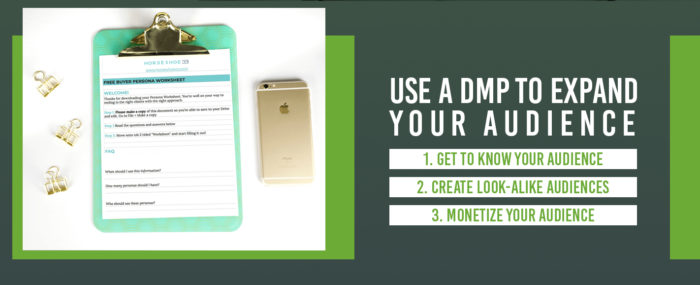
Use a DMP to Expand Your Audience
Publishers can also use their data and DMP to reach new audiences who are likely to become subscribers. Follow these steps to use your DMP to bring new users to your site.
1. Get to Know Your Audience
The first step is using your data to enhance your understanding of who your audience is. Using your DMP, you can learn about the various characteristics of your audience, including their demographic information, their interests, their preferences and the actions they take on your site. You can analyze this information to determine which types of users are most likely to subscribe.
It is useful to organize your audience into segments based on how likely they are to become subscribers. For example, you could create groups such as:
- Fly-bys: Those who visit your site once or only on occasion
- Loyal users: Those who visit your site regularly
- Newsletter readers: Those who have taken the step to sign up for your newsletter emails
- Subscribers: Those who have already signed up
This can be useful because newsletter readers are more likely than fly-bys, for example, to subscribe. You can also organize your audience according to other characteristics. For instance, you may find women in their 20s are most likely to subscribe to your magazine. You could organize your audience into demographic groups such as this so you can focus your efforts on those groups that are statistically most likely to purchase a subscription.
Tools such as Lotame Audience Profile Reports can help with this. These analyses are a feature of the Lotame DMP and help you learn about your audience by breaking it down into several sections based on demographics, behaviors, actions and interests. These reports enable you to see what characteristics your users have in common.
2. Create Look-Alike Audiences
Once you have an understanding of who your audience is, you can use that information to find new potential users through a method called look-alike modeling. You can use a tool like Lotame’s Data Informed Audiences, which uses machine learning to identify more of your target audience, to drive this process.
This first part of the look-alike modeling process involves analyzing the characteristics of your seed audience — the type of users you want to find more of. In this case, your seed audience would be users who became subscribers. Then, the lookalike modeling uses artificial intelligence to find users who have similar characteristics to those of your seed audience.
This automated audience targeting helps you to increase your pool of users with minimal manual work. The users you find through look-alike modeling will be likely to subscribe since they have characteristics similar to those of your subscribers. Lookalike modeling can continually adjust your target audience to optimize your results.
3. Monetize Your Audience
Improving your understanding of your audience and finding look-alike audiences can help you to increase revenue. Once you know who is most likely to become subscribers, you can target ads to them to bring them to your site and eventually to subscribe to your publication. With a DMP, you can export your audiences to paid media channels such as search, demand-side platforms or social media. You can use your campaign data to optimize your advertising spend by determining which types of ads and strategies work best, whether that’s free trials, special deals on bundles or appealing to the desire to support local journalism.
Data can help you to find new revenue models and improve the performance of your old strategies. If your site becomes more popular through your efforts to get more subscribers, you may be able to increase your advertising revenue as well. With data, you reduce the risk of failing to monetize your content.
5 Steps to Increase Subscribers with Customer Data
Advertising and subscriptions are two of the main focal points when it comes to driving revenue as a publisher. If you, like many publishers, are looking to driving subscriptions as a way to bolster revenue and not be so reliant on ad revenue, you may want to consider a few strategies based on existing customer data. Customer data, which you collect from multiple sources, can be combined into a data management platform (DMP) to drive insights about your readers, which your team can use to acquire, upsell, and retain loyal subscribers. Here are just a few strategies to consider how to increase subscribers.
1. Adjust Paywalls by Audience Type
Let’s say you already have a healthy chunk of subscribers, but you want to grow that loyal customer base. The first step to growing your subscription base is understanding who your current site visitors are.
Using your DMP, you could segment overall visitors into groups, such as:
- Fly-bys
- Loyal users
- Users that natively come to site (not from social or search)
- Newsletter readers
- Subscribers
Once you have different audience segments created, you can test different paywall meters against the different segments. For example, you could offer your die-hard loyal segment seven free pageviews per month before a paywall, whereas you can offer your lukewarm segment three free page views per month before the paywall.
2. Use AI to Find More Subscribers
Now that you have segmented your site visitors, you can take a closer look at who your subscribers are to help guide you to find more of those valuable subscribers. The audience profile reports available in your DMP offer insights into each audience broken down into a few main sections: Demographics, Behaviors, Actions, and Interests. You can use this information to learn more about your subscribers and how they overlap with one another, or what they have in common.
The next step is finding more of those subscribers using artificial intelligence (AI) to help identify more of that target audience. The specific tool you use may vary, but the concept remains the same. You start with a “seed” audience, i.e. the audience you want to find more of, which in this case is subscribers. For the purpose of building your subscriber seed list, you might consider segmenting visitors who are already subscribed to your newsletter, as newsletter subscribers often have the highest conversion rate to become subscribers. The AI will help find more prospective subscribers who look and act like your original seed group. This is an efficient method of building larger pools of prospective subscribers with less manual work for you.
3. Onboard Subscriber Data and Retarget Them Online
For publishers who have a solid offline base of subscribers, you may be focused on remaining top-of-mind and relevant to current subscribers via online touchpoints. Data onboarding brings your CRM, subscription or other offline data sources online, to be combined with other data from websites, apps, social, search, and more, for a complete view of your audience across screens.
What types of data can you bring online? All the most valuable data that publishers have coveted for decades, including email and street address data, where you mail the print copies of your publication directly to your subscribers. With all of your data online and in the same place, you can use it to create the most effective ad campaigns, compelling content, and insightful reporting and analytics — efficiently and cost-effectively. Retargeting your offline audience on a digital platform is another opportunity to engage with your loyal readers.
4. Highlight Premium/Paid Content
Your free newsletter subscribers or social media followers are an excellent option for upselling, since you know they are already interested in your content. They might just be waiting for the right offer to come along to convert to a paid subscriber, or maybe they don’t even know that there is a paid/premium option. The regular communications you have with these readers are an ideal platform to mention the availability of premium content. You can still deliver free content, but you should highlight your premium content. Make people see what they are missing and give them an opportunity right there to subscribe.
5. Conversion Rate Optimization on Your Subscription Page
The last and sometimes overlooked strategy to increase subscriptions is to take a closer look at your subscription page. Is it easy to find? Is it easy to navigate? Does it offer a good user experience? If the goal is to make people convert here, this should be a simple, streamlined process. The subscription page is also an opportunity for you to sell your premium content. Consider adding more meat to the page beyond just a form to be filled out with a price.
Acquiring, upselling and retaining subscribers is not impossible. These five strategies are not a comprehensive list, as marketing tactics and strategies are almost limitless. But if you’re looking to grow your subscriber base in 2019, you may want to give these a try.
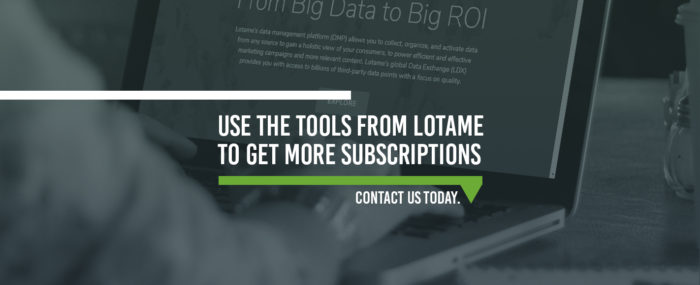
Use the Tools From Lotame to Get More Subscriptions
In the future of publishing, subscriptions are expected to become a larger part of how publishers drive revenue. Lotame’s data management platform and other tools can help publishers to grow their subscriber list and monetize their data in various other ways as well.
We can help publishers to get more subscriptions, grow their readership and increase their revenue. With our DMP, you can unlock the power of your data and combine it with data from other sources to enhance your understanding of your audience, create more engaging content and optimize your efforts to obtain new subscribers. You can also export it to other channels to expand your audience.
Data is a valuable resource for today’s publishers, and you need a flexible, capable DMP to take advantage of its potential. As the leading independent DMP, Lotame can be agile and responsive to our clients’ needs and offer world-class service and support as well as powerful technology. To learn more about our products and services or to request a demo, contact us today.